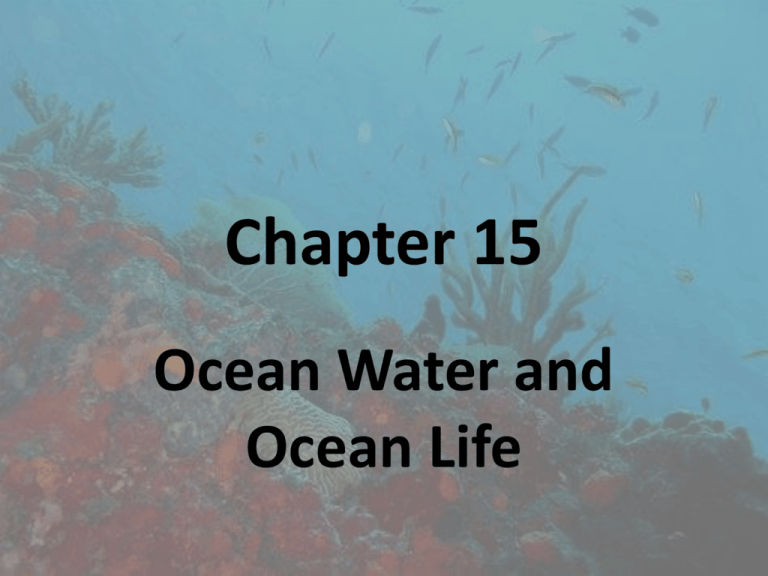Chapter 15 Ocean Water and Ocean Life
advertisement

Chapter 15 Ocean Water and Ocean Life Section 15.1 The Composition of Seawater The Composition of Seawater Salinity – is the total amount of solid material dissolved in water. • Because the proportion of dissolved substances in seawater is such a small number, oceanographers typically express salinity in parts per thousands. • Most of the salt in seawater is sodium chloride, common table salt. The Composition of Seawater • Sources of Sea Salt – Chemical weathering of rocks on the continents is one source of elements found in seawater. – The second major source of elements found in seawater is from Earth’s interior. • Volcanic eruptions emitted water vapor and elements – chlorine, bromine, sulfur and boron. Salts in Seawater The proportion of dissolved substances in seawater is usually expressed in A. B. C. D. Parts per hundred. Parts per thousand. Parts per ten thousand. Parts per million. Which of the following is a source of dissolved substances in the ocean? A. Chemical weathering of rocks B. Evaporation of water from the seas and ocean C. Excretions from marine organisms D. Melting icebergs and sea ice The Composition of Seawater Salinity • Processes Affecting Salinity – Processes that decrease salinity: • • • • Precipitation Sea ice melting Icebergs melting Runoff from land The Composition of Seawater Salinity • Processes Affecting Salinity – Processes that increase salinity: • Evaporation • Formation of sea ice Natural Processes Affecting Salinity Which does NOT decrease salinity? A. B. C. D. Precipitation Runoff Evaporation Ice melting The Composition of Seawater Ocean Temperature Variation • The ocean’s surface water temperature varies with the amount of solar radiation received, which is primarily a function of latitude. • Temperature Variation with Depth – The thermocline is the layer of ocean water between about 300 meters and 1000 meters where there is a rapid change of temperature with depth. – The thermocline is a very important structure because it creates a barrier to marine life. Variations in Ocean Surface Temperature Variations in Ocean Water Temperature The Composition of Seawater Ocean Density Variation • Density is defined as mass per unit volume. It can be thought of as a measure of how heavy something is for its size. • Factors Affecting Seawater Density – Seawater density is influenced by two main factors: salinity and temperature. The Composition of Seawater Ocean Density Variation • Density Variation with Depth – The pycnocline is the layer of ocean water between about 300 meters and 1000 meters where there is a rapid change of density with depth. Variation in Ocean Water Density Differing amounts of solar radiation across Earth’s latitude affect the ocean’s A. B. C. D. Salinity in the thermocline. Density at the surface. Temperature at the surface. Density in the thermocline. Which of the following occurs when the ocean’s salinity increases? A. B. C. D. Density increases Density decreases Temperature increases Temperatures decreases Which of the following occurs when temperature decreases? A. B. C. D. Density decreases Density increases Salinity increases Nothing happens The layer of ocean water between 300 meters and 1000 meters where there is a rapid change in density. A. B. C. D. Thermocline Transition zone Pycnocline Deep zone The Composition of Seawater Ocean Layering • Oceanographers generally recognize a threelayered structure in most parts of the open ocean: a shallow surface mixed zone, a transition zone, and a deep zone. • Does not exist in high latitudes because there is no rapid change in temp or density. 1. Surface Zone • • • Shallow (300 to 450 meters) Zone of mixing Sun-warmed zone The Composition of Seawater Ocean Layering 2. Transition Zone – Between surface layer and deep zone – Thermocline and pycnocline 3. Deep Zone – Sunlight never reaches this zone. – Temperatures are just a few degrees above freezing. – Constant high-density water Ocean Zones Which of these is NOT one of the three layers of the ocean? A. B. C. D. Photic zone Surface zone Transition zone Deep zone Where would you not find this threelayered structure of the open ocean? A. B. C. D. High latitudes Low latitudes Deep ocean zone Intertidal zone








